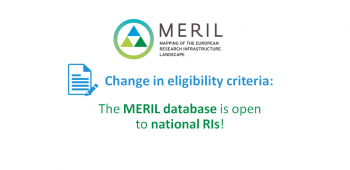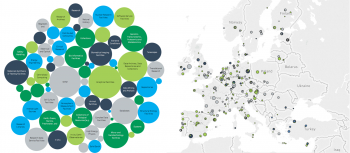
Europe-wide database of scientific research infrastructures revived under MERIL-2
A European Commission-funded project to revive and improve the MERIL database (Mapping of the European Research Infrastructure Landscape) database and portal is underway, with a new portal having been previewed on June 20 at an event in Rome, Italy.
The MERIL-2 project builds on the previous phases of MERIL that were initiated in 2010, with a view to building an up-to-date database of European research infrastructures across all scientific domains. With renewed funding from the European Commission under Horizon 2020 and an expanded team, the new three-year MERIL-2 project will provide the means for making informed assessments and decisions about the research infrastructure landscape in Europe, and to encourage accessibility, new partnerships and collaborations within the scientific community.
The MERIL-2 project will further expand the coverage of research infrastructures included in the database, and improve the depth and accuracy of the information held on them. The usability of the portal is also being developed through improved functionality and standardised data sets, which it is hoped will enable MERIL to become a hub for European research infrastructure information, resources and networking.
The MERIL database will enable individual research infrastructures to raise their profile and foster a greater sense of openness and partnership across Europe, while allowing scientists to access resources, services and facilities they may previously have been unaware of. The portal will also allow policy-makers to analyse and optimise the national and European research infrastructure funding landscapes by, for example, pinpointing gaps and identifying synergies at the European level. It will also encourage research infrastructures themselves to exchange best practice with a view to optimising the operation and exploitation of research infrastructures.
Ensuring that the data MERIL holds is of high quality and comparable is the utmost priority for the MERIL-2 project. In the new portal, information will be presented in a clearer and more usable way, and be quantitative where possible, enabling easier comparison and analysis. The new structure will also make it considerably easier for research infrastructures to submit and update their own data.
Ana Helman, MERIL Coordinator at the European Science Foundation (ESF), commented, “The original MERIL project was widely recognised as a valuable initiative, however in practice it faced a number of significant challenges and limitations. Now with renewed resources, an expanded team and having learnt from previous efforts, we believe MERIL-2 will realise the potential that such an initiative has to connect and inform the policy and research communities. The ambition for MERIL-2 is to be much more than a simple repository of information. It is to provide a destination website with dynamic content about research infrastructures, which will enable better use of existing resources and planning of future resources than is currently possible. We hope it will not only deliver significant value in its own right, but it will also lay the groundwork for similar initiatives to become interoperable in the future.The project is progressing well towards this ambition, and the demonstration of the new portal is a real milestone. However, in order to ensure data is kept up to date and to deliver sustained impact, the portal needs the European research infrastructure community to get behind it and help us to ensure it is as comprehensive as possible now and in the future.”
Johannes Janssen of Deutsche Forshungsgemeinschaft (DFG) and Chair of the MERIL Advisory Committee, said, “By mapping the landscape of research infrastructures that are of more than national relevance across all disciplines, the MERIL database enables a greater understanding of how research infrastructures can best support scientific users at the European level. The project is also helping to harmonise views on how to best utilise research infrastructures across Europe, particularly in bringing together and collaborating with the member state representatives who act as National Data Intermediaries. In taking a collaborative approach to developing MERIL, we are fostering a more unified approach for the future.
Jean-Claude Worms, Chief Executive of the European Science Foundation (ESF), added, “The MERIL portal will help to connect the scientific community by giving researcher stakeholders access to information on research infrastructures in Europe, their facilities, and areas of research. This will help researchers to pursue new opportunities, partner and collaborate with colleagues across Europe, and will be particularly useful for interdisciplinary teams. That the MERIL database is comprehensive in its coverage is of the utmost importance if the scientific and research infrastructure communities in Europe are to reap maximum value from the tools it provides. This is something that the MERIL team is prioritising and is an ongoing collaborative effort.”
The second generation MERIL portal can be accessed via this link. Considerable improvement works are still underway while the portal remains accessible to all, as the MERIL team invites feedback from the research infrastructure community.





